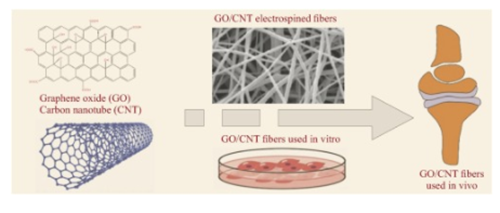Copyright © 2022 Foshan MBRT Nanofiberlabs Technology Co., Ltd All rights reserved.Site Map
Bone and cartilage defects may occur for various reasons such as degenerative, surgical, and traumatic diseases. Autograft and allograft transplantations have the inherent problems of donor tissue and risks of infection. Tissue engineering is a combination of scaffolds, cells, and bioactive molecules for the regeneration of injured tissue. Among various advanced materials, graphene oxide (GO) and carbon nanotubes (CNTs) have widely been examined for their potential in tissue engineering primarily due to their extraordinary physicochemical and mechanical properties as well as acceptable biocompatibility. Therefore, they have been used for cell proliferation, chondrogenic differentiation, and bone regeneration. In biomedical research, artificial three-dimensional (3D) biomaterials have been advanced for treating bone and cartilage defects. CNT and GO as promising materials can serve a similar microenvironment for the natural function of bone and cartilage such as mechanical strength. A variety of synthetic and natural polymers have been utilized to develop artificial bones and cartilages. In this review, we discuss the physicochemical characteristics of the GO- and CNT-based polymeric scaffolds and delineate their impacts on the cellular behaviors in cartilage and bone regeneration, including cell attachment, growth, and differentiation into osteoblast and chondrocyte. We also impart on the development of the 3D hydrogel-based scaffolds, electrospinning, and 3D-printing methods as well as their potential in bone and cartilage tissue engineering.

Published: 2021
Journal :Mater Today Commun
Impact Factor:2.582
Paper link:https://www.sciencedirect.com/science/article/abs/pii/S2352492821000891